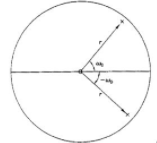A digital resonator is required to be designed including 3 dB bandwidth, with frequency Na, that yield zero magnitude at extreme frequencies. What will be the transfer function of such a resonator? (I)determine the impulse gain. (I1)determine the impulse gain response for the designed filtered (III)Determine the bandwidth?
A digital resonator is required to be designed including 3 dB bandwidth, with frequency Na, that yield zero magnitude at extreme frequencies. What will be the transfer function of such a resonator? (I)determine the impulse gain. (I1)determine the impulse gain response for the designed filtered (III)Determine the bandwidth?
Digital Resonator: A digital resonator is a special kind of bandpass filter having a pair of complex conjugate poles located near the unit circle as shown in the figure below. Digital resonators are second-order recursive filters.

To design a digital resonator with a resonant frequency at

It is required to select the complex conjugate poles at

Now let us select that zeros are located at +1 and -1 such that it eliminates the response at the corner frequencies( ), i.e.,
), i.e.,

for getting zero magnitudes at extreme frequencies.
The general transfer function of the digital resonator is given by:

Now, when the zeros are placed at +1 and -1 ( ), then the system transfer function will be
), then the system transfer function will be

Step by step
Solved in 4 steps with 16 images









